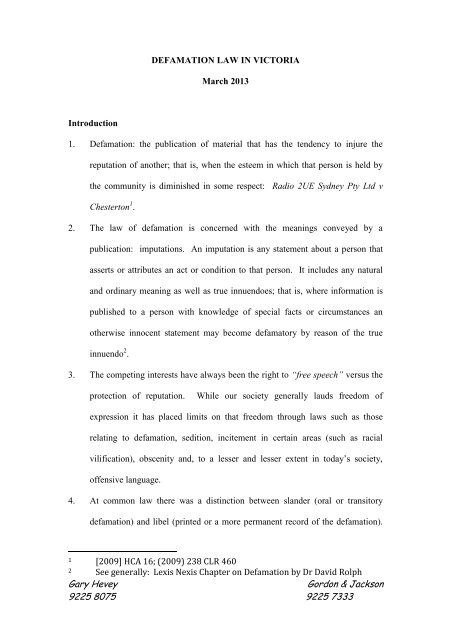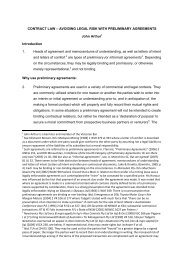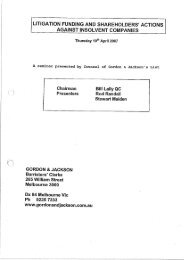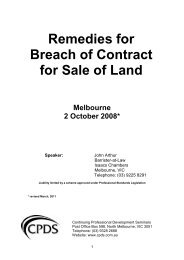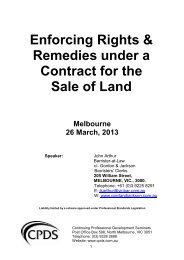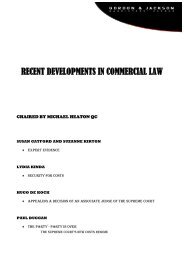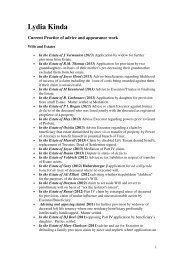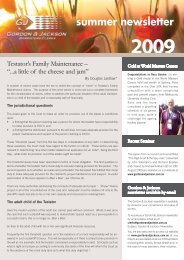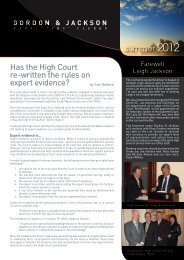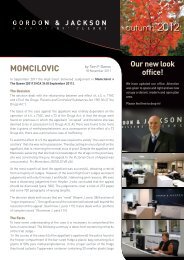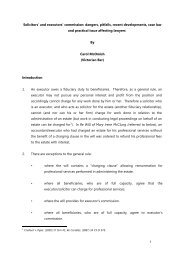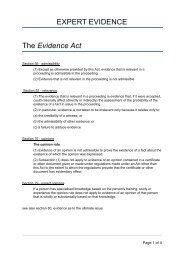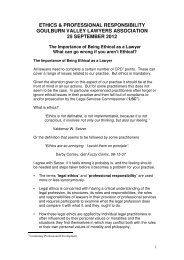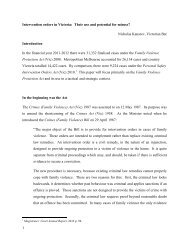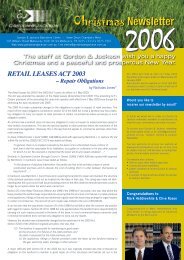Gary Hevey Gordon & Jackson 9225 8075 9225 7333 ...
Gary Hevey Gordon & Jackson 9225 8075 9225 7333 ...
Gary Hevey Gordon & Jackson 9225 8075 9225 7333 ...
You also want an ePaper? Increase the reach of your titles
YUMPU automatically turns print PDFs into web optimized ePapers that Google loves.
DEFAMATION LAW IN VICTORIA<br />
March 2013<br />
Introduction<br />
1. Defamation: the publication of material that has the tendency to injure the<br />
reputation of another; that is, when the esteem in which that person is held by<br />
the community is diminished in some respect: Radio 2UE Sydney Pty Ltd v<br />
Chesterton 1 .<br />
2. The law of defamation is concerned with the meanings conveyed by a<br />
publication: imputations. An imputation is any statement about a person that<br />
asserts or attributes an act or condition to that person. It includes any natural<br />
and ordinary meaning as well as true innuendoes; that is, where information is<br />
published to a person with knowledge of special facts or circumstances an<br />
otherwise innocent statement may become defamatory by reason of the true<br />
innuendo 2 .<br />
3. The competing interests have always been the right to “free speech” versus the<br />
protection of reputation.<br />
While our society generally lauds freedom of<br />
expression it has placed limits on that freedom through laws such as those<br />
relating to defamation, sedition, incitement in certain areas (such as racial<br />
vilification), obscenity and, to a lesser and lesser extent in today’s society,<br />
offensive language.<br />
4. At common law there was a distinction between slander (oral or transitory<br />
defamation) and libel (printed or a more permanent record of the defamation).<br />
1 [2009] HCA 16; (2009) 238 CLR 460<br />
2 See generally: Lexis Nexis Chapter on Defamation by Dr David Rolph<br />
<strong>Gary</strong> <strong>Hevey</strong><br />
<strong>Gordon</strong> & <strong>Jackson</strong><br />
<strong>9225</strong> <strong>8075</strong> <strong>9225</strong> <strong>7333</strong>
2<br />
That distinction is abolished by the Defamation Act 2005 3 . The ever changing<br />
world of communications through social media is leading to new challenges as<br />
will be highlighted later in this paper.<br />
5. The tort of defamation provides a remedy in damages designed to vindicate the<br />
aggrieved person’s reputation and to provide consolation, insofar as can be done<br />
by money, for the hurt suffered by the aggrieved person. At common law<br />
damages were at large and included compensatory, aggravated, exemplary and<br />
punitive damages.<br />
6. In March 2010 a jury in the Supreme Court of Victoria awarded Dyson Hore-<br />
Lacey SC of the Victorian Bar $600,000 by way of compensatory damages plus<br />
$30,000 for exemplary damages having found him to have been defamed in a<br />
book entitled Getting Away With Murder concerning the defence raised in the<br />
Ramage murder case of 2003.<br />
The book, written by Mr Phil Cleary and<br />
published by Allen and Unwin, suggested certain conduct by Hore-Lacy.<br />
Interest and costs were in addition to the amount awarded and was one of the<br />
largest claims awarded in Victoria. One other that remains in memory is that of<br />
Ron Clarke, athlete extraordinaire, who in 2000 sued the ABC’s 7.30 Report<br />
for comments made alleging that he was building a sporting complex over a<br />
toxic dump. While his solicitors had sent a Calderbank offer shortly before trial<br />
indicating that the plaintiff was prepared to settle for $75,000 the jury awarded<br />
him $1,000,000 for the hurt to his reputation.<br />
7. A few other cases that indicate the value placed on reputations might be thought<br />
to be at different ends of the scale are mentioned here having regard to the cap<br />
on damages introduced by the uniform legislation that will be covered shortly.<br />
3 Sub-section 7(1)<br />
<strong>Gary</strong> <strong>Hevey</strong><br />
<strong>Gordon</strong> & <strong>Jackson</strong><br />
<strong>9225</strong> <strong>8075</strong> <strong>9225</strong> <strong>7333</strong>
3<br />
Mr Andrew Ettinghausen a well-known rugby league player in New South<br />
Wales sued as a result of a magazine publishing a photograph of him in a<br />
shower after a match, the photograph was revealing; a jury compensated Mr<br />
Ettinghausen to the amount of $350,000. The NSW Court of Appeal thought<br />
the hurt not to be that large and reduced the damages to $100,000. In a similar<br />
matter Ms Sonia Shepherd, a then 31-year-old mother from Hervey Bay in<br />
Queensland was awarded $120,000 when a magazine, without her permission,<br />
published a nude photograph of her. Mr Kennett, a former premier of this State<br />
reportedly received a settlement from Channel 9 in the order of $400,000. Ms<br />
Jelena Popovic, Magistrate received $250,000 when Mr Andrew Bolt inferred<br />
that she was soft on crime and unfit to be a Magistrate. Mr John Marsden, a<br />
former president of the New South Wales Law Society sued Channel 7 in 1999<br />
over allegations aired in Witness and Today Tonight that Mr Marsden had<br />
engaged in sexual conduct with under age boys. He was awarded $525,000 plus<br />
millions of dollars in indemnity costs (his lawyers had made an offer of<br />
compromise $500,000) with reports indicating that legal costs in this, a very<br />
long running case, amounted to around $18 million dollars. Channel 7 appealed<br />
and lost.<br />
8. Other matters that might be of interest include, the case commenced by Mr<br />
Alphonse Gangitano against the journalist Mr John Silvester and 3AW after Mr<br />
Silvester alleged Mr Gangitano had “the brains of a flea and the genitalia to<br />
match”. I have not seen the pleadings but I assume that both parts of the<br />
sentence were alleged to be defamatory. Regrettably, Mr Gangitano apparently<br />
experienced some difficulty with a Mr Jason Moran, and as a result of an early<br />
demise, was unable to see the proceedings through to the door of the Court.<br />
<strong>Gary</strong> <strong>Hevey</strong><br />
<strong>Gordon</strong> & <strong>Jackson</strong><br />
<strong>9225</strong> <strong>8075</strong> <strong>9225</strong> <strong>7333</strong>
4<br />
The final matter that I would remind you of was the celebrated case concerning<br />
the late Mr Frank Hardy, author of that wonderful Victorian novel, Power<br />
Without Glory. Mrs Ellen Wren, the widow of Mr John Wren, a colourful<br />
identity and businessman, who some were unkind enough to think might have<br />
been the subject upon which Mr Hardy based his story’s hero/villain (please<br />
circle as you see fit), had the then 34 year old Hardy arrested and charged with<br />
criminal libel. I will return later to the famous Hardy name.<br />
9. The personalities involved in defamation litigation over the years are, as<br />
interesting as are the matters to which they took offence, the courses chosen by<br />
them to restore their reputations, and the results of their various quests. All of<br />
the above matters are of public domain and I would refer those with prurient or<br />
otherwise motivated interest in such matters to www.maynereport.com where a<br />
rich treasury of many household names awaits.<br />
The Defamation Act 2005 - The Uniform Legislation<br />
10. On 1 January 2006 the Defamation Act 2005 came into operation 4 . It is part of<br />
the uniform law of defamation that has existed since that time in all jurisdictions<br />
in Australia. The Act changed the law in many ways and since that time has<br />
been the starting point for any matter involving allegations of, or considerations<br />
of defences in relation to, defamation.<br />
11. The objects of the act refer to uniformity of defamation in Australia, the need to<br />
ensure that there is no unreasonable limits on freedom of expression, especially<br />
in relation to matters of public interest and importance, to provide effective<br />
4 Section 2 – Unless otherwise stated all references are to the Defamation<br />
Act 2005. The Act is known as the Defamation Act in all jurisdictions in Australia<br />
except the ACT where it forms part of the Civil Law (Wrongs) Act 2002.<br />
<strong>Gary</strong> <strong>Hevey</strong><br />
<strong>Gordon</strong> & <strong>Jackson</strong><br />
<strong>9225</strong> <strong>8075</strong> <strong>9225</strong> <strong>7333</strong>
5<br />
remedies for persons whose reputations are harmed and to promote speedy and<br />
non-litigious methods of resolving disputes 5 .<br />
12. The Act relates to the tort of defamation at general law and does not affect the<br />
operation of the general law except as provided for in the Act 6 .<br />
13. The Act abolishes the distinction between libel and slander 7 . The<br />
importance of this abolition is that the publication of defamatory matter of any<br />
kind is actionable without proof of special damage 8 . Before the Act any action<br />
for slander required proof of special damage by the plaintiff before they could<br />
be compensated by damages.<br />
14. Where there are a number of defamatory matters published at the one time then<br />
only a single action may be brought, even if more than one defamatory<br />
imputation is carried by the matter 9 . This does not mean, for example, that<br />
where different potential defendants publish the same defamation then the<br />
plaintiff is limited to one action.<br />
As many actions are open as there are<br />
publishers. An example of the potential for multiple actions is demonstrated by<br />
the cases of Trkulja v Yahoo! 10 and Trkulja v Google Inc (No 5) 11 . Each of<br />
those matters concern publications on the internet alleging that the plaintiff was<br />
either involved in criminal activities, so involved with crime in Melbourne that<br />
his rivals had hired a hit man to murder him, or that he was such a significant<br />
figure in the Melbourne criminal underworld, that events involving him are<br />
recorded on a Web site that chronicles crime in Melbourne. The plaintiff<br />
5 Section 3<br />
6 Section 6<br />
7 Sub-section 7(1)<br />
8 Sub-section 7(2)<br />
9 Section 8<br />
10 [2012] VSC 88<br />
11 [2012] VSC 533<br />
<strong>Gary</strong> <strong>Hevey</strong><br />
<strong>Gordon</strong> & <strong>Jackson</strong><br />
<strong>9225</strong> <strong>8075</strong> <strong>9225</strong> <strong>7333</strong>
6<br />
succeeded in both actions when the respective juries found he had been<br />
defamed. In the Yahoo! matter Kaye J assessed damages at $225,000 plus<br />
interest and costs, and in the Google matter, Beach J assessed damages at<br />
$200,000. There were slight differences in the findings by each of the juries but<br />
on any reading of the cases the assessment of damages was well toward the<br />
maximum amount available to the plaintiff under the Act. I shall return later to<br />
amounts awarded by way of damages since the introduction of the Act.<br />
15. Section 9 of the Act restricts those corporations who can sue for defamation<br />
to those who might broadly be described as, not-for-profit corporations, or a<br />
corporation that employs fewer than ten persons and is not related to another<br />
corporation; so long as either of such corporations is not a public body.<br />
16. As mentioned in relation to Mr Gangitano’s matter his action lapsed with his<br />
death. No cause of action for or against a deceased person (including a<br />
personal representative of the deceased) is open even if the action was<br />
commenced before the death of the person 12 .<br />
17. The choice of law, a question that was often a very real one before the<br />
introduction of the uniform legislation, is now governed by factors set out in<br />
section 11 of the Act. If publication is within one jurisdiction then that will be<br />
where the action is, if in more than one jurisdiction then it is where the harm<br />
occasioned by the publication has its closest connection and, in deciding that,<br />
the court will take into account where the plaintiff was ordinarily resident or the<br />
extent of the publication in each relevant jurisdiction.<br />
12 Section 10<br />
<strong>Gary</strong> <strong>Hevey</strong><br />
<strong>Gordon</strong> & <strong>Jackson</strong><br />
<strong>9225</strong> <strong>8075</strong> <strong>9225</strong> <strong>7333</strong>
7<br />
Alternative dispute resolution process<br />
18. Part 3 of the Act is entitled Resolution of Civil Disputes without Litigation.<br />
As mentioned earlier one of the objects of the Act as set out in section 3 is to<br />
promote speedy and non-litigious methods of resolving disputes about the<br />
publication of defamatory matter.<br />
19. The Act provides that a publisher may make “an offer to make amends” to an<br />
aggrieved person and any such offer to make amends is taken to have been<br />
made without prejudice, unless the offer provides otherwise 13 . Such an offer is<br />
dependant upon the aggrieved person giving a notice in writing to the publisher<br />
of their concerns (a concern notice) informing the publisher of the defamatory<br />
imputations alleged to have been made (the imputations of concern). Upon<br />
receipt of the concern notice the publisher has 28 days in which to make the<br />
offer to make amends or to request further particulars from the aggrieved<br />
person. If a request for further particulars is made then the plaintiff has 14 days<br />
to provide them 14 .<br />
20. An offer to make amends must include a number of matters listed in section 15<br />
of the Act and, should you ever find yourself in a position that you are assisting<br />
a client to prepare one, you should use section 15 as a check list to ensure that<br />
the offer will have its full effect should the matter proceed to litigation. Apart<br />
from the obvious offer to make amends (or to attempt to) for the perceived<br />
defamation and suitable publication thereof there must also be an offer to pay<br />
reasonable expenses incurred by the aggrieved person while there may also be<br />
an offer to pay a stated amount or to pay an amount to be determined by an<br />
13 Section 13<br />
14 Section 14<br />
<strong>Gary</strong> <strong>Hevey</strong><br />
<strong>Gordon</strong> & <strong>Jackson</strong><br />
<strong>9225</strong> <strong>8075</strong> <strong>9225</strong> <strong>7333</strong>
8<br />
arbitrator appointed by the parties or, finally, to pay the amount determined by a<br />
court. If a court is the chosen path then the court will be the court in which any<br />
proceedings have already been issued and, if none have yet been issued then in<br />
the Supreme Court 15 .<br />
21. There is power for an offer to make amends to be withdrawn 16 .<br />
22. If the offer to make amends is accepted, and carried out, then the aggrieved<br />
person cannot assert, continue or enforce any action for defamation in relation<br />
to the matter which will then, in effect, be regarded as settled 17 . A court may<br />
(but need not) order the publisher to pay the aggrieved person expenses<br />
reasonably incurred as a result of accepting the offer and order any costs<br />
incurred that form part of those expenses be assessed on an indemnity basis 18 .<br />
23. Like many such provisions there is a sting in the tail for an aggrieved person<br />
who chooses not to accept an offer to make amends. An offer to make amends,<br />
and its rejection, may be pleaded as a defence by the publisher and a court will<br />
look objectively at the offer to determine whether it was reasonable in all the<br />
circumstances, and if it is judged to be so, an otherwise potentially successful<br />
action may well fail 19 .<br />
24. Any admissions that are made in any offer to make amends is inadmissible in<br />
any action for defamation whether civil or criminal although such admissions<br />
may be considered when looking at the effects of this part of the Act and,<br />
perhaps obviously, in any question as to costs 20<br />
15 Sub-sections 15(3) and 15(4)<br />
16 Section 16<br />
17 Section 17<br />
18 Sub-section 17(2)<br />
19 Section 18<br />
20 Section 19<br />
<strong>Gary</strong> <strong>Hevey</strong><br />
<strong>Gordon</strong> & <strong>Jackson</strong><br />
<strong>9225</strong> <strong>8075</strong> <strong>9225</strong> <strong>7333</strong>
9<br />
25. In similar vein apologies offered by a publisher does not constitute an express<br />
or an implied admission and is also inadmissible in any proceedings in like<br />
manner to the offer to make amends 21 .<br />
Manner of trial<br />
26. Litigation can be tried, at the election of either party, by a jury although the<br />
court can veto such a request if the trial will involve a prolonged examination of<br />
records or involves technical, scientific or other issue that cannot be<br />
conveniently be considered and resolved by a jury 22 .<br />
I make no comment on<br />
this apparent comment on trial by jury!<br />
27. While the jury (if one has been allowed) has the task of deciding whether<br />
defamation has occurred and whether a defence has been successful, should the<br />
plaintiff succeed it will be the judicial officer who decides what damages are to<br />
be paid 23 . It is to be noted that nothing in section 22 affects any law or practice<br />
relating to special verdicts.<br />
28. Section 23 prevents the bringing of a second action by the aggrieved person<br />
against the same defendant in a different jurisdiction without leave of the court<br />
to do so.<br />
Defences<br />
29. The Act does not affect the defences or exclusion of liability that may be<br />
available to a defendant under the general law 24 . An example cited in the Act is<br />
21 Section 20<br />
22 Section 21<br />
23 Section 22<br />
24 Section 24<br />
<strong>Gary</strong> <strong>Hevey</strong><br />
<strong>Gordon</strong> & <strong>Jackson</strong><br />
<strong>9225</strong> <strong>8075</strong> <strong>9225</strong> <strong>7333</strong>
10<br />
section 19 of the Constitution Act 1975 conferring privileges and immunities on<br />
members of parliament. Importantly, while the state of mind of a publisher may<br />
not be relevant in the plaintiff’s case it may be relevant in defeating a defence<br />
raised 25 .<br />
30. Contextual truth is a defence if the defamatory imputations do not further<br />
harm the reputation of the plaintiff because of the substantial truth of the<br />
contextual imputations 26 .<br />
31. Absolute privilege is a defence, i.e. matters said within parliament or court<br />
including accurate publication of the same 27 . Likewise the publication of public<br />
documents document or a fair summary or extract from a public document is a<br />
defence 28 .<br />
The definition of public document restricts the meaning to<br />
government, curial and quasi government type documents.<br />
32. A defence of fair reporting of proceedings of public concern is provided for<br />
by the Act 29 but this defence, once established, is defeated, if, and only if, the<br />
plaintiff proves that the defamatory matter was not published honestly for the<br />
information of the public or the advancement of education 30 . Interestingly,<br />
learned societies, sports associations and trade associations are all included<br />
within the definition of matters that relate to “proceedings of public concern”.<br />
33. A defence of qualified privilege exists if the defendant proves that the recipient<br />
of the defamatory material had an apparent interest in having information on the<br />
subject, and, the matter is published to give the recipient information on that<br />
25 Sub-section 24(2)<br />
26 Section 26<br />
27 Section 27<br />
28 Section 28<br />
29 Section 29<br />
30 Sub-section 29(3)<br />
<strong>Gary</strong> <strong>Hevey</strong><br />
<strong>Gordon</strong> & <strong>Jackson</strong><br />
<strong>9225</strong> <strong>8075</strong> <strong>9225</strong> <strong>7333</strong>
11<br />
subject and finally that the conduct of the defendant is reasonable in the<br />
circumstances 31 . The matters that a court will take into account in assessing<br />
whether the criteria for qualified privilege have been met are set out in section<br />
30 but, as mentioned earlier, this defence can be defeated if the plaintiff proves<br />
malice but note that merely because reward is associated with the publication<br />
does not equate to malice 32 .<br />
34. A defence of honest opinion can be made out if the opinion was of public<br />
interest and is based on proper material and such defence extends to employers/<br />
principals of commentators who might express defamatory honest opinions 33 .<br />
This defence too may be defeated if, and only if, the plaintiff proves that the<br />
opinion was not honestly held at the time of publication, or in the case of an<br />
employer/principal that they did not believe that the opinion was honestly held<br />
by the commentator.<br />
35. There is a defence of innocent dissemination where an employee/agent or<br />
subordinate distributor and in that capacity did not know, nor could not<br />
reasonably have been expected to know that the statement was defamatory 34 .<br />
Such a defence is likely to be raised where matters have been published on the<br />
internet and an aggrieved person seeks to sue those who might be seen to have<br />
the deepest pockets, Google and Yahoo perhaps? Despite the earlier mentioned<br />
matters involving Mr Trkulja and both Google and Yahoo the matter is not yet<br />
settled as to whether search engines are in fact publishers of such material.<br />
31 Section 30<br />
32 Sub-sections 30(4) and 30(5)<br />
33 Section 31<br />
34 Section 32<br />
<strong>Gary</strong> <strong>Hevey</strong><br />
<strong>Gordon</strong> & <strong>Jackson</strong><br />
<strong>9225</strong> <strong>8075</strong> <strong>9225</strong> <strong>7333</strong>
12<br />
36. The very recent decision of Mansfield J in the Federal Court matter of Rana v<br />
Google Australia Pty Ltd, Darda Gregurev, Nina Gregurev and Google Inc 35 is<br />
an example that the law on publication and the defences is still in a state of<br />
development. The New Zealand Case of A v Google New Zealand Ltd 36<br />
considered that in order to be held liable as a publisher of defamatory material it<br />
must be the case that the defendant “could have prevented the continued<br />
publication of the material” or had the ability to bring about the cessation of<br />
that material. The NZ court found that because of Google New Zealand being a<br />
subsidiary of Google Inc the named defendant did not have the power to prevent<br />
or bring about the cessation of the publication of the relevant material. A<br />
similar decision was reached in Tamiz v Google Inc and Google UK Ltd 37 .<br />
37. Following the reasons in the NZ and UK cases cited Mansfield J held that, on<br />
the facts before him in the Rana Case, Mr Rana had no reasonable prospect of<br />
success and dismissed the action against Google Australia.<br />
Mansfield J<br />
considered the differing approaches taken in Tamiz and Trkulja v Google Inc<br />
LLC (No 5) and decided that as the law was not yet settled he would not, on that<br />
basis, refuse to give leave to serve the proceedings on Google Inc which would<br />
have had the effect of effectively dismissing that claim. His Honour gave Mr<br />
Rana 28 days to file and serve a Further Amended Statement of Claim so that<br />
the question of granting leave for overseas service might be considered in light<br />
of the fresh pleadings.<br />
38. The differing views expressed in Tamiz and Trkulja are important. Eady J in<br />
Tamiz used the analogy of a graffitied wall and queried whether the owner of a<br />
35 [2013] FCA 60 – judgment handed down 7 February 2013<br />
36 [2012] NZHC 2352, cited in Rana at para 38 of that judgment<br />
37 [2012] EWHC 449 (QB), cited in Rana at para 39 of that judgment<br />
<strong>Gary</strong> <strong>Hevey</strong><br />
<strong>Gordon</strong> & <strong>Jackson</strong><br />
<strong>9225</strong> <strong>8075</strong> <strong>9225</strong> <strong>7333</strong>
13<br />
wall daubed with defamatory material could be said to be the publisher of it;<br />
Beach J, on the other hand, expressed the view that it was open to the jury in his<br />
case to find that Google was the publisher of the defamatory material because<br />
the search engine operates precisely as intended by those who own it and who<br />
provide its services. It should also be noted that in the Trkulja Case notice of<br />
the offending material had been provided to Google Inc and Beach J found that<br />
it was open to the jury to find that after receipt of such notice, “as infelicitous<br />
as the letter of 22 September 2009 might have been”, the defendant did not<br />
make out its defence of innocent dissemination.<br />
39. The final defence contained in the Act is that of triviality, which relates to<br />
circumstances where the publication was such that it was unlikely that the<br />
plaintiff would sustain harm as a result 38 .<br />
Damages<br />
40. Damages in any action are to bear an appropriate and rational relationship to the<br />
harm sustained by the plaintiff 39 . In the normal course of events damages for<br />
non-economic loss are limited to $250,000 (plus CPI increases since 1 January<br />
2006) 40 . However, if the court is satisfied in the circumstances the<br />
publication(s) is such as to warrant an award of aggravated damages then the<br />
figure may be exceeded 41 . Importantly, the state of mind of the defendant at the<br />
38 Section 33<br />
39 Section 34<br />
40 Sub-section 35(1) – present value just over $300,000<br />
41 Sub-section 35(2)<br />
<strong>Gary</strong> <strong>Hevey</strong><br />
<strong>Gordon</strong> & <strong>Jackson</strong><br />
<strong>9225</strong> <strong>8075</strong> <strong>9225</strong> <strong>7333</strong>
14<br />
time of the publication is irrelevant, except where malice, or other state of mind,<br />
affects the harm sustained by the plaintiff 42 .<br />
41. The awarding of exemplary or punitive damages was abolished by the Act 43 .<br />
42. Factors that will mitigate damages include an apology, a correction, the fact that<br />
a plaintiff has issued or compromised or recovered damages from other<br />
proceedings in relation to any other publication of matter having the same<br />
meaning, or effect, as the subject defamatory matter 44 .<br />
43. Damages for multiple causes of defamation may be assessed as a single sum 45 .<br />
44. I make some general observations to perhaps dispel the view that there may be a<br />
river of gold awaiting a person defamed.<br />
45. In another case involving Mr Trjulka, while successful, the damages awarded<br />
were modest. In 2009 Mr Trkulja sued Ms Trajkovska for defamation. The<br />
defendant did not contest the proceedings, she did not appear at court. Mr<br />
Trjulka was successful. The allegation was that the defendant had alleged to<br />
have said to a group of five friends that Mr Trjulka had drugged her causing her<br />
to become ill and lose sleep and that the plaintiff was guilty of a serious crime.<br />
Similar allegations were allegedly made shortly after to another small group of<br />
about twenty-four people, this time the allegation included that the plaintiff was<br />
selling illegal drugs and that he once offered to sell his own daughters into<br />
prostitution at the ages of five and six. Of interest was that the first publication<br />
was alleged to have occurred on or about 6 January 2003 and the second on or<br />
about 7 January 2003. Proceedings were not issued until 24 March 2009. One<br />
42 Section 36<br />
43 Section 37<br />
44 Section 38<br />
45 Section 39<br />
<strong>Gary</strong> <strong>Hevey</strong><br />
<strong>Gordon</strong> & <strong>Jackson</strong><br />
<strong>9225</strong> <strong>8075</strong> <strong>9225</strong> <strong>7333</strong>
15<br />
can only presume that as the defendant took no part in the proceedings any<br />
question of limitations periods was not raised. Judge Davis 46 was guided by the<br />
terms of the Act and considered the matter relating to Ms Popovic, (referred to<br />
earlier in this paper 47 ), as well as the case of Winn v Goodwin 48 (where Judge<br />
Shelton had awarded $30,000 in relation to defamatory statements repeated in<br />
correspondence to VCAT) and finally a decision of Judge Campbell in the<br />
matter of Gluyas v Tenana 49 (where $20,000 was awarded to a defendant who<br />
had defamed the plaintiff on the World Wide Web). Waving some judicial<br />
magic wand Judge Davis awarded Mr Trkulja the princely sum of $3,000 by<br />
way of compensatory damages. Mr Trkulja was also compensated $960.50 for<br />
his own costs (as a self represented party) together with interest of $104.40.<br />
46. Lest you should think that the County Court is the only court where damages<br />
might be somewhat less than expected I would also refer you to the case of<br />
Amanatidis v Darmos 50 . In that matter Ms Anastasia Darmos caused to be<br />
delivered to one person, and personally delivered to a priest, a letter containing<br />
defamatory material of the husband and wife plaintiffs concerning the<br />
disposition of the assets of a family member.<br />
Ms Darmos was the male<br />
plaintiff’s sister. The relevant deceased was their father. The case was hard<br />
fought with silk and junior for the plaintiffs and a Mr P. Darmos appeared for<br />
Ms Darmos. The judgment does not record whether counsel for the defendant<br />
was related to her although Wilson QC, for the plaintiff, alleged that there was<br />
further aggravation caused by the manner in which the defendant’s case was<br />
46 Trkulja v Trajkovska [2010] VCC 0010<br />
47 [2002] VSC 220<br />
48 [2008] VCC 1507<br />
49 [2008] VCC 1161<br />
50 [2011] VSC 163<br />
<strong>Gary</strong> <strong>Hevey</strong><br />
<strong>Gordon</strong> & <strong>Jackson</strong><br />
<strong>9225</strong> <strong>8075</strong> <strong>9225</strong> <strong>7333</strong>
16<br />
conducted and sought aggravated damages accordingly. Taking everything into<br />
account Sifris J awarded the husband plaintiff $5,000 by way of compensatory<br />
damages and the wife (who had been accused of robbing the dead by taking<br />
money and papers from the deceased’s pockets – a defamation which His<br />
Honour regarded as “particularly serious”) was awarded $10,000 which sum<br />
included an unspecified amount for aggravated damages.<br />
47. To provide a broader picture for the 2011 year the largest recorded award of<br />
damages was $150,000 was in the matter of Nowark v Putland 51 where the<br />
plaintiff was allegedly called a “paedophile” and a “wog” while at a Surf Live<br />
Saving Club. However, on appeal 52<br />
the judgment was overturned and the<br />
matter was sent back for a retrial before a different judge with the Court of<br />
Appeal exhorting the parties to consider whether some other form of settlement<br />
could occur under the ancient legal maxim: enough is enough. The average in<br />
New South Wales 2011 was $71,286 with the two largest recorded awards<br />
being $100,000 each 53 .<br />
48. As mentioned earlier in the paper the late Mr Frank Hardy suffered the indignity<br />
of being arrested and charged with criminal defamation. His grand daughter Ms<br />
Marieke Hardy was recently involved in a defamation action concerning Mr<br />
Johua Meggitt. Ms Hardy had been the subject of what she described as a hate<br />
blog against her. Regrettably, on 9 November 2011 she incorrectly identified<br />
Mr Meggitt as the man responsible for writing the blog under the nom de guerre<br />
of James Vincent McKenzie. That matter settled for a reported $13,000 with<br />
Ms Hardy, clearly the victim of defamation herself, having to pay Mr Meggitt<br />
51 Queensland District Court at Southport delivered 8 November 2011<br />
52 Putland v Nowak [2012] QCA 121 – judgment delivered 11 May 2012<br />
53 www.justinian.com.au/bloggers/hateful-blogging.html<br />
<strong>Gary</strong> <strong>Hevey</strong><br />
<strong>Gordon</strong> & <strong>Jackson</strong><br />
<strong>9225</strong> <strong>8075</strong> <strong>9225</strong> <strong>7333</strong>
17<br />
for “outing” the wrong man. One can only assume that Ms Hardy will search<br />
for the correct blogger and seek to make good the money that she has lost.<br />
Costs<br />
49. It is important to remember that in matters involving defamation the potential<br />
for the award of costs on an indemnity basis to the successful party is very<br />
real 54 . Having regard to the attempts to resolve matters before ending at court a<br />
successful party may be in a strong position when arguing that having<br />
reasonably attempted to settle the matter then they ought to be awarded<br />
indemnity costs as allowed under the Act.<br />
Time limits – ONE YEAR<br />
50. The other matter that is of paramount importance to any solicitor considering<br />
a potential defamation action is the time limit. In the original Act section 48<br />
prescribed the relevant time limits for the commencement of an action but these<br />
were repealed in 2011 and are now to be found in sections 5(1AAA) and 23B of<br />
the Limitation of Actions Act 1958. Section 5(1AAA) prescribes one year from<br />
the date of publication for the bringing of an action for defamation. There is<br />
provision within section 23B to extend that period to a maximum of three years<br />
(but no longer) where it was not reasonable in the circumstances for the plaintiff<br />
to have commenced an action in relation to the matter complained of within one<br />
year of the publication. An application for an extension may be made even<br />
though the one year period has passed.<br />
54 Section 40<br />
<strong>Gary</strong> <strong>Hevey</strong><br />
<strong>Gordon</strong> & <strong>Jackson</strong><br />
<strong>9225</strong> <strong>8075</strong> <strong>9225</strong> <strong>7333</strong>


